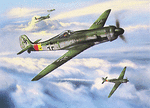lesofprimus
Brigadier General
The Sea Fury was designed to fight a different type of fighter than the Bearcat.... The Bearcat was a much more agile and powerful fighter....
And at altitude, I agree LG... The -152H was, in the hands of an Ace, extremely deadly over 35,000 feet...
And at altitude, I agree LG... The -152H was, in the hands of an Ace, extremely deadly over 35,000 feet...

